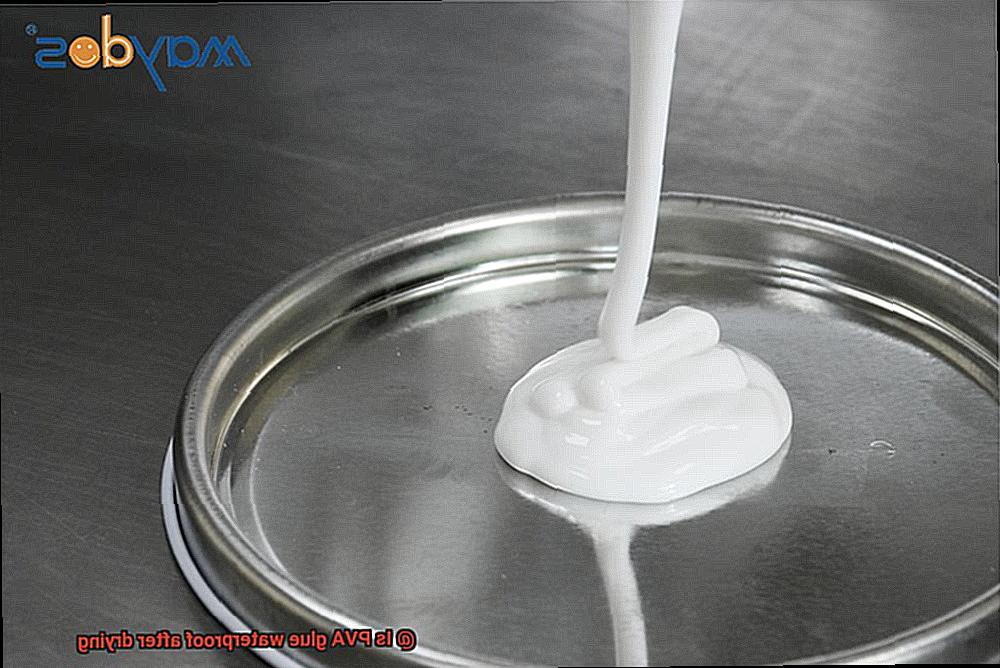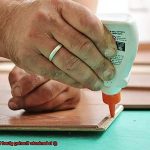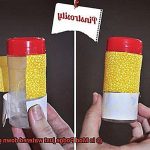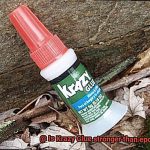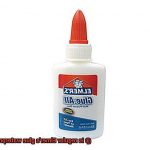Do you ever wonder if your PVA glue can hold up against water after it dries? You’re not alone. Many people believe that PVA glue is water-resistant, but the truth is, not all PVA glues are created equal. There are variations in waterproofing abilities and factors that can affect its performance.
As a woodworking or DIY enthusiast, using the right type of glue for the job is crucial. When it comes to water resistance, having a glue that can withstand wet environments is essential. But how do you know which PVA glue fits the bill?
Let’s explore this question together in this blog post. We’ll dive into the science behind PVA glue and its ability to resist water, as well as different types of PVA glues and their varying waterproofing abilities. We’ll also discuss how to use PVA glue properly for maximum water resistance and tips for selecting the best one for your next project.
Whether you’re an experienced DIYer or just curious about the science of glue, get ready to learn everything you need to know about whether or not PVA glue is truly waterproof after drying. So sit back, relax, and let’s get started.
What is PVA Glue?
Contents
Its water-soluble nature and clear drying properties make it a versatile adhesive that can be used on various surfaces such as paper, wood, fabric, and some plastics.
One of the most significant advantages of PVA glue is its simplicity. It can be easily applied using a brush or spreader, and it dries relatively quickly. Once dried, it forms a strong bond that makes it ideal for holding together materials such as paper or wood.
While PVA glue possesses some water-resistant properties, it is not entirely waterproof after drying. It can resist small amounts of water without breaking down or losing its adhesive properties. However, if exposed to large amounts of water or prolonged exposure to moisture, it will start to break down and lose its adhesive strength.
Fortunately, there are ways to make PVA glue more water-resistant. You can mix the glue with a waterproofing agent such as silicone sealant or waterproofing powder to increase its water-resistance and make it suitable for use in damp or wet environments.
What’s more, PVA glue is an affordable adhesive option that can be purchased in small bottles for individual use or in larger containers for more significant projects. Due to its clear drying properties, it can be used in various applications without leaving any visible residue.
Is PVA Glue Waterproof After Drying?
PVA glue, also known as white glue, is a popular choice for woodworking, paper crafts, and other DIY projects. But is it waterproof after drying? As an expert in this field, I can tell you that while PVA glue is not entirely waterproof, it does have some water-resistant properties that make it suitable for certain applications.
Let’s explore the properties of PVA glue. It is a water-based adhesive that dries clear and is easy to clean up with water. PVA glue is known for its strong bonding properties and is commonly used in various crafts. However, when exposed to water, PVA glue has limitations.
When PVA glue comes into contact with water, it softens and loses its adhesive properties. This means that if your project is exposed to water, the glue will break down, and your project may fall apart. So why isn’t PVA glue waterproof after drying? The reason lies in the composition of the glue. PVA glue contains a polymer emulsion suspended in water. Once the water evaporates, the polymer particles bond together to create a strong adhesive bond. However, this bond can break down when exposed to water.
However, some types of PVA glue are formulated to be more water-resistant than others. These types of PVA glues contain additives such as polyvinyl acetate (PVA) emulsions or acrylics that improve their water-resistance. These are commonly used in outdoor applications such as woodworking projects that will be exposed to rain or moisture.
Benefits of PVA Glue
This polyvinyl acetate-based glue has become a favorite among crafters, DIY enthusiasts, and professionals alike for its versatility and excellent bonding properties.
PVA glue is a water-based adhesive that dries clear and flexible, making it perfect for a wide range of surfaces including paper, cardboard, wood, and fabric. Whether you’re creating a scrapbook or building a model airplane, PVA glue is the perfect adhesive to bring your project to life.
One of the major benefits of PVA glue is its safety. It is non-toxic and safe to use, making it ideal for children’s crafts or projects involving food containers or utensils. Plus, it’s easy to clean up with soap and water while still wet.
Another advantage of PVA glue is its ability to offer both temporary and permanent bonding options. When used in its wet form, it can act as a temporary adhesive that allows for repositioning of the glued items before it dries. Once dry, it forms a strong and durable bond that can withstand regular wear and tear.
Lastly, PVA glue is affordable and accessible. Compared to other types of adhesives such as epoxy or cyanoacrylate, PVA glue is relatively cheap and can be found at most craft or hardware stores. This makes it an accessible option for those on a budget or those who need to purchase a large quantity for a particular project.
How to Make PVA Glue More Waterproof
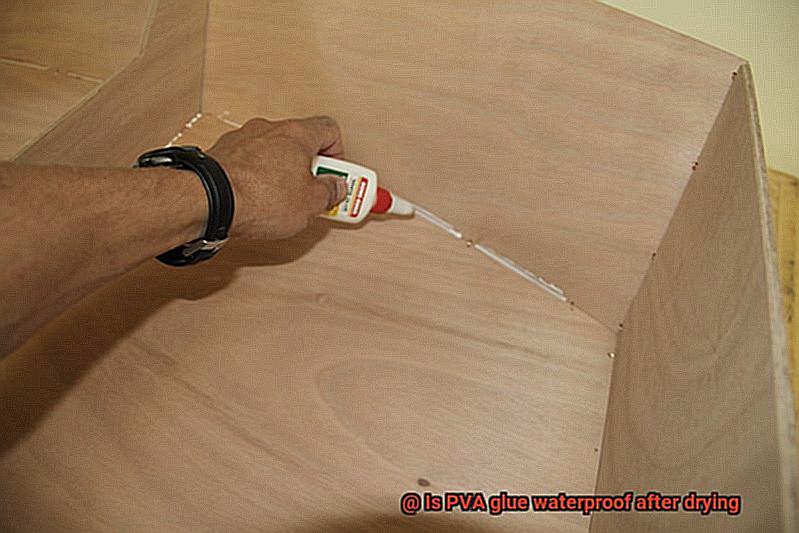
PVA glue is a versatile adhesive that can be used for a variety of projects. However, one downside to this type of glue is that it’s not entirely waterproof. Fortunately, there are several ways to make PVA glue more water-resistant.
Mix with a Waterproofing Agent
One effective method for increasing the water-resistance of PVA glue is to mix it with a waterproofing agent like silicone or acrylic. This creates a more durable bond that can withstand exposure to water without breaking down. To do this, simply add a small amount of the waterproofing agent to the PVA glue and mix thoroughly before use.
Apply a Waterproof Sealer
Another way to make PVA glue more waterproof is to apply a waterproof sealant on top of the dried glue. This adds an extra layer of protection against water damage and can help extend the life of your project. You can use a clear polyurethane or another waterproofing sealant and brush it on over the surface of the project.
Test Small Batches First
It’s essential to test small batches of your PVA glue mixture before using it on a larger project. Adding other substances to PVA glue can change its properties, such as its drying time and overall strength. It’s always best to be cautious and ensure that your mixture works as intended.
Avoid Exposing Glued Items to Water
While these methods can help make PVA glue more water-resistant, they do not make it completely waterproof. It’s important to avoid exposing your glued item to water as much as possible, especially for extended periods of time. If you need an adhesive that can withstand prolonged exposure to water, you may need to consider using a different type of glue that is specifically designed for this purpose.
Types of Applications for PVA Glue
PVA glue, also known as white glue or school glue, is a cost-effective and versatile adhesive that can be used for a wide range of applications. Here are five sub-sections that showcase the different types of projects you can use PVA glue for.
Woodworking
PVA glue is an excellent choice for bonding wood together. It dries clear and can be sanded down to a smooth finish, making it ideal for woodworking projects of all sizes. Whether you’re building a birdhouse or a bookshelf, PVA glue can help ensure a strong bond that will last.
Paper crafts
PVA glue is an essential tool in paper crafts such as scrapbooking or card making. It dries quickly and doesn’t wrinkle or warp the paper, making it perfect for attaching embellishments or creating intricate designs.
Bookbinding
PVA glue is a popular choice for bookbinding because it creates a strong bond and can be easily applied with a brush or roller. Whether you’re repairing an old book or creating a new one, PVA glue can help ensure the pages stay together for years to come.
Sealing surfaces
PVA glue can also be used as a sealer for porous surfaces such as concrete or plaster before painting or finishing. This creates a smooth surface for painting or decorating while also providing extra protection against wear and tear.
Textile crafts
PVA glue makes an excellent adhesive for textile crafts such as applique or fabric painting. It’s safe to use on most fabrics and dries clear, making it perfect for adding embellishments to clothing or creating unique designs on fabric.
Different Types of Adhesives and Their Uses
Adhesives are essential for bonding two or more materials together. There are many different types of adhesives available, each with its unique characteristics and uses. Here are five sub-sections that explain the different types of adhesives and their uses in detail.
PVA Glue
PVA glue, also known as white glue or school glue, is a water-based adhesive that is easy to use and dries clear. It’s a popular choice for crafts, woodworking, and household repairs. It can bond porous materials such as wood, paper, and cloth. However, it’s not completely waterproof, so it’s not suitable for projects that require exposure to water.
Cyanoacrylate Glue
This adhesive is also known as super glue. Cyanoacrylate glue is fast-drying and creates a strong bond between two surfaces. It’s commonly used for small repairs and bonding materials such as metal, plastic, or ceramic. This adhesive works best on non-porous surfaces and is not recommended for fabrics or paper.
Epoxy Glue
Epoxy glue is known for its strength and durability. It consists of two parts: a resin and a hardener that are mixed together to create a strong bond. Epoxy glue is ideal for bonding materials such as wood, metal, glass, and plastic. It’s resistant to water, chemicals, and heat.
Hot Glue
Hot glue guns are commonly used for arts and crafts projects or DIY repairs. They work by heating up a solid adhesive stick and melting it onto the surface to be bonded. Hot glue is versatile and can bond various materials such as fabric, wood, plastic, and foam.
Polyurethane Glue
Polyurethane glue, also known as Gorilla Glue, creates a strong bond that can withstand exposure to water, heat, and chemicals. It expands as it dries, filling any gaps or irregularities in the surface for an even stronger bond. Polyurethane glue is ideal for bonding materials such as wood, metal, ceramic, and plastic.
Alternatives to PVA Glue
As an expert in alternative adhesives, I’m here to share some fantastic options.
Let’s start with epoxy, a two-part adhesive that creates a strong and durable bond. It’s versatile as it can be used on surfaces like wood, metal, and plastic. Furthermore, it dries clear and is waterproof, making it the ideal choice for projects that will be exposed to water.
For those looking for a quick-drying option, cyanoacrylate glue (super glue) is perfect. This adhesive forms a strong bond on surfaces like metal, plastic, and wood and is also waterproof.
If flexibility or movement is required for your project, silicone adhesive is a viable option. It dries clear and can be used on surfaces like glass, metal, and plastic. Silicone adhesive is both waterproof and flexible, making it perfect for those types of projects.
Lastly, marine-grade adhesives are ideal for projects that require the toughest water exposure. These specialized adhesives are designed specifically for use on boats and other watercraft. They’re incredibly strong and waterproof.
Tips for Using PVA Glue
PVA glue, also known as white glue, is a versatile adhesive that can be used for a wide range of projects. However, to ensure a successful project, it is important to consider some tips when using PVA glue.
Choose the Right Type of PVA Glue
Before starting your project, make sure you choose the right type of PVA glue. Each type has different properties and is designed for specific applications. Using the wrong type of PVA glue can result in weak bonds or even damage to your project. For example, wood glue is ideal for woodworking projects, while school glue is great for paper crafts.
Apply the Glue Evenly
To ensure a strong bond, it is important to apply the glue evenly. This can be done using a brush or roller to spread the glue over the surface you want to bond. For smaller projects, a toothpick or cotton swab may be used to apply the glue precisely. A thin layer of glue is usually sufficient for most projects.
Clamp or Press the Parts Together
After applying the glue, clamp or press the parts together to help ensure that the bond is strong and secure. This step is particularly important for projects where strength and durability are essential. It is recommended to allow the glue to dry completely before removing the clamps or pressure.
Avoid Applying Too Much Glue
While it may be tempting to apply more glue than necessary, this can lead to excess dripping and messiness. Moreover, too much glue can weaken the bond and result in an unsightly finish. A small amount of glue is usually sufficient for most projects.
Use Waterproof PVA Glue for Outdoor Projects
If you are working on an outdoor project or a project that may come into contact with water, it is recommended to use a waterproof PVA glue. Regular PVA glue may not hold up well when exposed to moisture or water over time. Waterproof PVA glue is specially formulated to be water-resistant and can help ensure the longevity of your project.
Bnq00TC97tI” >
Also Read: Is white glue waterproof when dry?
Conclusion
In conclusion, PVA glue is a versatile adhesive that can be used for a wide range of DIY projects. It possesses some water-resistant properties, but it’s not entirely waterproof after drying. The composition of PVA glue contains a polymer emulsion suspended in water, which breaks down when exposed to large amounts of water or prolonged exposure to moisture. However, don’t let this discourage you as there are ways to make PVA glue more water-resistant.
You can mix it with a waterproofing agent or apply a waterproof sealant on top of the dried glue to increase its resistance to water. This affordable and accessible adhesive option comes in small bottles for individual use or larger containers for significant projects. Its safety and ease of cleanup with soap and water make it ideal for children’s crafts or projects involving food containers or utensils.
PVA glue is suitable for woodworking, paper crafts, bookbinding, sealing surfaces, and textile crafts. But if you need an adhesive that can withstand prolonged exposure to water, consider using a different type of glue specifically designed for this purpose.
When using PVA glue, choose the right type for your project and apply it evenly while avoiding applying too much of it. Clamping or pressing the parts together and using waterproof PVA glue for outdoor projects are also essential tips to ensure successful bonding.
In summary, PVA glue is an excellent choice for many DIY projects due to its affordability, accessibility, and versatility.

